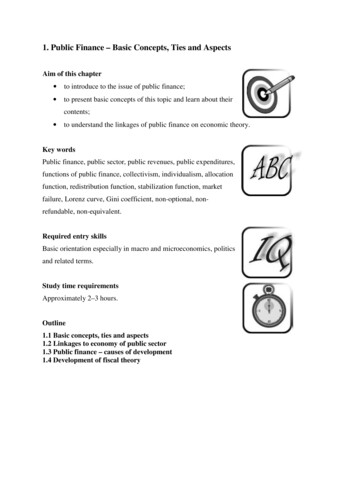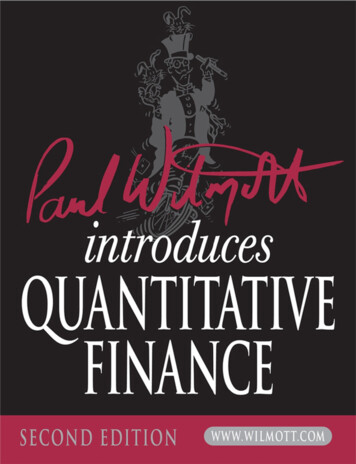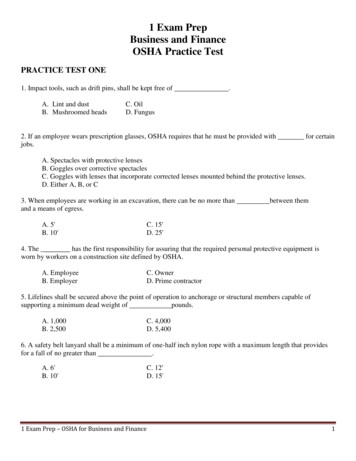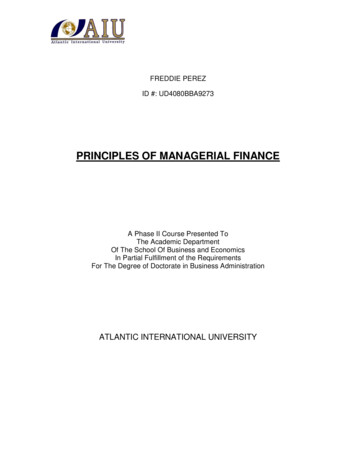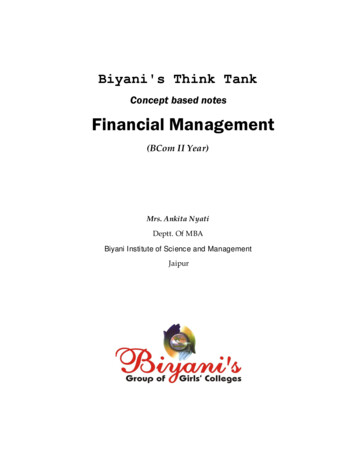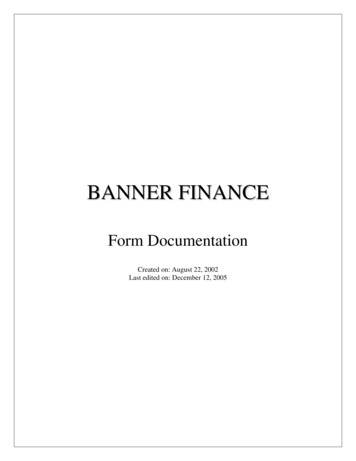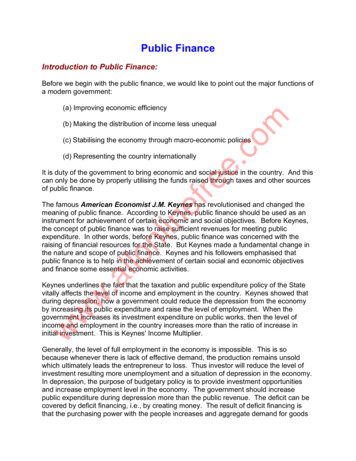
Transcription
Public FinanceIntroduction to Public Finance:Before we begin with the public finance, we would like to point out the major functions ofa modern government:(b) Making the distribution of income less unequalcom(a) Improving economic efficiency(d) Representing the country internationallye.(c) Stabilising the economy through macro-economic policiesefreIt is duty of the government to bring economic and social justice in the country. And thiscan only be done by properly utilising the funds raised through taxes and other sourcesof public finance.allonlinThe famous American Economist J.M. Keynes has revolutionised and changed themeaning of public finance. According to Keynes, public finance should be used as aninstrument for achievement of certain economic and social objectives. Before Keynes,the concept of public finance was to raise sufficient revenues for meeting publicexpenditure. In other words, before Keynes, public finance was concerned with theraising of financial resources for the State. But Keynes made a fundamental change inthe nature and scope of public finance. Keynes and his followers emphasised thatpublic finance is to help in the achievement of certain social and economic objectivesand finance some essential economic activities.wwwKeynes underlines the fact that the taxation and public expenditure policy of the Statevitally affects the level of income and employment in the country. Keynes showed thatduring depression, how a government could reduce the depression from the economyby increasing its public expenditure and raise the level of employment. When thegovernment increases its investment expenditure on public works, then the level ofincome and employment in the country increases more than the ratio of increase ininitial investment. This is Keynes' Income Multiplier.Generally, the level of full employment in the economy is impossible. This is sobecause whenever there is lack of effective demand, the production remains unsoldwhich ultimately leads the entrepreneur to loss. Thus investor will reduce the level ofinvestment resulting more unemployment and a situation of depression in the economy.In depression, the purpose of budgetary policy is to provide investment opportunitiesand increase employment level in the economy. The government should increasepublic expenditure during depression more than the public revenue. The deficit can becovered by deficit financing, i.e., by creating money. The result of deficit financing isthat the purchasing power with the people increases and aggregate demand for goods
and services increases. Owing to increase in aggregate demand and the operation ofmultiplier, the depression will tend to disappear and the economy will move towards fullemployment.ree.comOn the contrary, whenever, there is a higher effective demand and when the moneysupply is increased, there will be a generation of inflation in the economy. In such asituation, the purpose of fiscal policy to reduce money supply in the economy so as toreduce the inflationary pressure and so people can save more and consume less.When there is inflation in the economy and the prices are soaring higher and higher, thegovernment should levy heavy taxes and in this way withdraw purchasing power fromthe people and should also reduce its own expenditure. The demand having beenreduced in this way, prices would tend to come down. It is clear that to fight inflation,the government should frame a 'surplus budget'. A surplus budget means that thegovernment should collect more money from the public by imposing more taxes butkeep its expenditure less than the revenue raised. The result will be that lesspurchasing power will be left with the people and the aggregate demand for goods willbe reduced. Consequently, the prices will have a tendency to fall.allonlinefThe above situation is mostly existed in economically advanced and rich countries. Theless developed countries, like Pakistan, Bangladesh, India, China, Myanmar, etc. arecaught up in the vicious circle of poverty and their main problem is to break this circleand move towards economic development so that poverty is removed and the livingstandard of the people is raised. The objectives of public finance in less developedcountries are to give a fill up to capital formation, encourage industrialisation, encourageproductive investment, and foster economic growth. Thus the objectives of publicfinance in less developed countries are different from those in the developed countries.Whereas in developed countries, the function of public finance is to accelerateeconomic growth so that the widespread unemployment and poverty prevailing in thecountry are removed.wCauses of Market Failure / Reasons of Government's Intervention inMarket Economy:wwThe market economic system operates under Price Mechanism. Consumers show theirwill or desire to buy a commodity at a given price in order to maximise their utility. Onthe other hand, the producers are aimed at maximising their profit for what theyproduce. In market economy, there is no justification for state intervention but there aresome reasons that necessitate the government's intervention in the economy asdiscussed below:(a) To avoid Monopoly: Monopoly is a situation in which one seller rules over thewhole industry. The buyers are compelled to purchase commodity at the price fixed bythe monopolist. Therefore, the government interferes for the benefits of the consumers.The government interferes in pricing of the commodity, and/or encourages new firms toenter into the market/industry.
(b) To maintain Price Mechanism: There may be possibilities of prevailing anunjustified price mechanism even in the presence of perfect competition in the market.The government can monitor the prices fixed by the market and protect the consumersfrom the burden of unjustified prices.com(c) To meet Externalities: Externalities represents those activities that affect others forbetter or worse, without those others paying or being compensated for the activity.Externalities exist when private costs or benefits do not equal social costs or benefits.There are two major species, i.e., external economy and external diseconomy. In suchsituation, government intervene the market with its different policies.ree.(d) Increasing Social Welfare and Benefits: Another strong reason of government'sintervention in the market economy is the social welfare and benefit. It is one of theduties of an elected government to work for the common welfare of the nation; toprovide social goods and services, like hospitals, education facilities, parks, museums,water and sewerage, electricity, old age benefits, scholarships, etc; and the protect thepeople from the evils of a laissez faire economy.inef(e) To meet Modern Macro-Economic Issues: It is the duty of the government toensure that the country is in a right direction of economic development. Governmentmust ensure controlled inflation, greater employment opportunities, rapid technologicaladvancement, adequate capital formation, and higher economic growth rate.nlGovernmental Activities / Actions taken by the Government:.alloIntervention of government in the economy takes a number of forms. The governmentmay undertake the conduct of production, or may influence private economic activity bysubsidies or taxes, or they may exercise direct control over behaviour on the privatesector. Finally, governments may transfer purchasing power from some persons toothers. The government activities can be broadly classified into four groups:www(a) Allocative Activities: These activities alter the overall mix of gross national product.The allocative activities arise out of the failure of the market mechanism to adjust theoutputs of various goods in accordance with the preferences of society. The ultimategoal of the government is to maximise per capita income.(b) Efficiency in Resource Utilisation: Maximum efficiency in the use of resourcesrequires the attainment of three conditions:(i) Attainment of least cost combinations(ii) Operation of the firms at the lowest long-run average cost(iii) Provision of maximum incentive for developing and introducing new techniques.
While the private sector is presumed to be less deficient, on the whole, in attainingoptimal efficiency than in attaining optimal allocation of resources, nevertheless inseveral situations governments may be more effective.(c) Stabilisation and Growth Activities: are those activities reducing economicinstability and unemployment and increasing the potential and actual rates of economicgrowth.com(d) Distributional Activities: are those activities altering the pattern of distribution ofreal income.Approaches of Government Actions:e.Following are the approaches or tools of government action plan against themalfunctions of market economy:efre(a) Governmental Conduct of Production: The public goods such as defence, lawenforcement, etc are supplied by the government, since their inherent character theycannot be produced and sold on a profit-making basis by private enterprise.nlinGovernment may also undertake education. In order to adapt the nature and quality ofeducation to meet community goals, governments produce the services directly,although allowing private enterprise to provide them as well for persons who prefer theprivate product.alloGovernment conduct of production may also be undertaken for efficiency reasons - toavoid collection costs, to obtain advantages of longer-term investments, or to attaineconomies of scale.www(b) The Subsidy Approach: An alternative to governmental production is subsidisationof private producers to induce them to increase output or to undertake investments thatthey would not otherwise make. Thus private schools could be subsidised to provideadditional education at prices less than those equal to marginal cost. Subsidies mightalso be used to increase investment to lessen unemployment or to lower output whencarried beyond the optimal figure.(c) The Control Approach: For some purposes, direct control of private sector activity,with no governmental production except the limited amount involved in administration ofthe regulatory rules, is a satisfactory solution. Activity that gives rise to significantexternal costs, such as pollution, may be subjected to controls, such as requirementsfor adequate waste disposal. Monopoly may be broken up by antitrust laws ormonopoly firms may be subjected to detailed regulation of rates and services. This formof regulation creates a continuous clash of interest between government and the firms.(d) Aggregate Spending: Prevention of unemployment and attainment of the potentialrate of economic growth or prevention of inflation may require fiscal and monetary
policies that influence aggregate demand in the economy. To eliminate unemploymentthe government may raise the level of public spending and the scope of its activitiesbeyond the levels as warranted, or may reduce taxes below the optimal levels.e.Pareto Optimality / New Welfare Economics:com(e) Transfer Payments: Transfer payments are made by the government for bringingdown the inequality in income distribution more closely in line with the desired one.Transfer payments may be 'specific' or 'non-specific', for example, scholarships inuniversities are specific, and provision of education and parks free of charge is nonspecific. Non-specific transfer payments or general transfer payments are made on thebasis of the income status of the recipients in conjunction with various criteria of needs.For example, old age benefits, aid for dependent children, direct relief, or negativeincome tax.inefreThe New Welfare Economics represents a break with the utilitarian tradition inEconomics. The new welfare economists claim to arrive at optimum conditions ofproduction and exchange without adding the utilities of different persons or comparingthe satisfactions of different individuals. The new welfare economics is claimed to beobjective and scientific and not ethical. It is said that welfare economics furnishes ananalysis of the causes governing the measure of welfare or an increase or decreasethereof. Italian born Vilferdo Pareto is said to be the pioneer of new welfare economics,although there have been introduced some subsequent refinements since then.allonlThe Italian Economist Vilferdo Pareto has laid down the conditions for maximisingsocial welfare or for achieving a social optimum. A Paretian optimum refers to asituation in which it is impossible to make any one better off without making some oneworse off. For judging such a situation, Pareto has enunciated a very simple andstraightforward criterion thus: "Any change which harms no one and which makes somepeople better off (in their own estimation) must be considered to be an improvement."wwwIn the following diagram, an example of a community is taken, in which there are onlytwo persons X and Y:
The utility of X is represented along horizontal axis and that of Y along the vertical axis.The Pareto criterion states that if we start off from a situation which is represented by apoint like A, then a policy change by the Government is an improvement if it results in amove to any point like B or C which lies to the right of A or above. At B, X is better offthan at A with Y as well off as before, whereas the move to C benefits Y withoutharming X and the move to D, benefits both the persons.Conditions of Paretian Optimum:comThe conditions of Paretian optimum are given below:efree.(a) Optimum Allocation of Products: Allocation of products to be optimal must besuch as to make it impossible for any pair of individuals to exchange any quantity of anypair of consumer goods resulting in increase in one's satisfaction without decreasingthat of another. That is, if any alternative allocation can increase some one'ssatisfaction without decreasing another's, it is not optimal. To put in terms ofindifference curve technique, the marginal rate of substitution (MRS) between any twogood must be same for any pair of owners of the same two goods. We know that MRSis the rate at which units one good can be exchanged for the units of another withoutlowering the level of satisfaction.www.allonlinThis can be explained with the help of an Edgeworth Box diagram. The Edgeworthdiagram for consumption shows the indifference curve preference maps of the twoindividuals and their derived levels of satisfaction from the various combinations ofgoods. The indifference curve preference maps of both A and B have been combinedand shown with the help of an Edgeworth Box in the following figure:The indifference curve preference map of A starts from origin O, whereas theindifference curve preference map of B starts from origin O'. I 1 to I 8 represents theindifference curves of individuals A and B. I 1 , I 2 , I 3 and I 4 represent the indifferencecurves of individual A, and I 5 , I 6 , I 7 and I 8 represent the indifference curves of individualB. The slope of an indifference curve, as we know, at any point is the marginal rate ofsubstitution between commodities X and Y (MRS xy ). The point would be optimal where
comthe MRS xy of both individuals are same. If the MRS xy is not the same, then with thehelp of exchange, it is possible to increase the level of satisfaction of one withoutdiminishing that of the other. Now if we joint the points L, M, N, P where the differentsets of indifference curves of individuals A and B are tangent to each other, we get acurve known as 'Contract Curve', i.e., cc'. The points L, M, N and P lie on the contractcurve cc'. At each of these points, the MRS xy for A and B is the same. Therefore, eachpoint along a contract curve cc' represents a point of Pareto-optimality. In other words,any redistribution of the goods X and Y between A and B will yield a lower level ofsatisfaction.ree.(b) Optimum Degree of Specialisation: It refers to the condition that the marginal rateof transformation (MRT) between any two goods must be the same for any pair of firmsproducing both of them. The MRT between two goods is the amount of one good whichwould have to be sacrificed to produce one unit of another good. This only means theratio of marginal opportunity cost of the two goods. Obviously, if MRT is not the samefor any pair of producers, it would be possible to increase the combined output of thetwo goods or increase the output of one without decreasing that of another. This willmean that the present degree of specialisation is not the optimum.nlinef(c) Optimum Factor Utilisation: This represents optimum relationship between thefactor and the product. The utilisation of a factor will be optimal if the marginal rate oftransformation (MRT) between any factor and any product is the same for any two firmsusing the factor and producing the product. If MRT is not the same, it will be adeparture from the optimum.w.allo(d) Optimum Allocation of Factors: All factors of production must be so allocatedamong the various uses that the marginal production in each use is that same. If it isnot the same, it will pay to shift some units of a factor from one use to another. In termsof new economics, the marginal rate of technical substitution (MRTS) between any pairof factors must be the same for any two firms using both to produce the same product.Only then, the allocation will be optimal. If it is not, it will be possible to increase thetotal product by shifting a factor from one firm to another.ww(e) Optimum Direction of Production: Another condition for maximising welfare is thatthe marginal rate of substitution between any pair of products for any person consumingboth must be the same as the marginal rate of transformation for the communitybetween them. In terms of utility analysis, it means:(i) That the ratios of marginal utilities of the two goods must be the same for allconsumers, i.e.,MU of APrice of A MU of BPrice of Band so on.This will represent maximum satisfaction of the consumer.
(ii) The ratio of their marginal costs must be the same for all producers producingthem, i.e.,MC of APrice of A MC of BPrice of Band so on.(iii) These ratios must be equal.comThis condition relates to the maximum efficiency of the economic system. The goodsmust be produced in such combinations that they not only conform to consumers'preferences but are also produced at the minimum average cost. If it is technicallypossible to substitute one good for another and make one better off without makinganother worse off, the production is not optimal.nlinefree.Let us take a community producing two goods. The quantity of each good it produceswill depend on its factor endowments and on its existing technical knowledge. By factorendowments we mean the amounts of factors of production the community possesses.Let us assume that the community can produce either 100 bushels of wheat or 100yards of cloth when all its factors are fully and most efficiently employed in theproduction of either wheat or cloth respectively. The various combinations of wheat andcloth that it can produce are shown by the 'production possibility curve' or the'transformation curve'. If the community chooses to produce wheat only, it can produce100 bushels. If it would also like to produce cloth, it must forgo the production of someof its wheat. The amount of wheat, which the community foregoes in order to have anextra unit of cloth, is known as the 'opportunity cost' of wheat in terms of cloth.www.alloIn the following diagram, the community's production possibility curve drawn on theassumption of increasing opportunity cost. The meaning of increasing opportunity costis that the amount of extra wheat the community produces by decreasing production ofcloth with given factors is steadily increasing.
Let us superimpose the indifference curve preference map, i.e., I 1 and I 2 of an individualA on AB production possibility curve. Now the Pareto-Optimal point would be where theslope of production possibility curve AB and of the indifference curve (A) is the same ortangent. In this diagram, point P is the optimal point, as the slope of the indifferencecurve I 2 and PB on curve AB is the same. The point Q is not the point of optimum.com(f) Optimum Allocation of a Factor-Unit's Time: The owner of a factor unit has theoption of using the factor to render him a direct service or hiring it out to others foraiding in production. Hence, the problem for the owner of a factor is to allocate the timeof factor rendering direct services or working for a money reward in an optimal manner.efree.(g) Inter-Temporal Allocation of Assets: Every individual firm has to bring about anoptimal allocation of factor inputs and product output over time. A firm may produce agiven output stream with various time patterns of factor inputs and conversely, it mayhave various time patterns of outputs with a given input stream of factor services. Itrefers to the allocation of products or factors that may relate to different moments oftime. In this case, the allocation will bring maximum welfare when the marginal rate ofsubstitution between any pair of moments is the same for every pair of individuals orfirms.w.allonlinThe above-discussed conditions are also known as 'First-Order Conditions'. From theabove first-order conditions, the Pareto-Optimality can be attained. But the fulfilment ofthese first-order conditions may not be enough to lead to welfare optimality. To achievean optimum welfare position, it is very necessary that the 'Second-Order Conditions'along with the first order conditions should also be satisfied to achieve the maximumwelfare. These second order conditions are no other than the stability conditions forequilibrium position. The fulfilment of second order conditions means that all theindifference curves and the production possibility curves should have the right curvaturein the neighbourhood of any position where marginal conditions are satisfied. In theneighbourhood of maximum welfare, all indifference curves must be convex to the originand all transformation curves must be concave to it.wwIn the following figure, AB is the production possibility curve of the community, I 1 and I 2are the indifference curves of an individual. The point b is a point of optimum welfare asthe indifference curve I 2 , is a tangent to the production possibility curve AB. At point a,the indifference curve I 1 is also a tangent to the production possibility curve AB but it isnot a point of optimum welfare, as by moving from a to b, the community reaches on ahigher indifference curve I 2 .
come.Relation between Pareto Optima and Perfect Competition:inefre(a) Equality of Marginal Rate of Substitution: Under conditions of perfectcompetition, the consumer in order to maximise satisfaction makes the marginal rate ofsubstitution between any two goods equal to the ratio of their prices. At equilibrium, theMRS between two goods is equal to the ratio of their prices for any consumer.Therefore, the first condition of optimum allocation of goods of Pareto-optimality issatisfied under perfect competition.allonl(b) Equality of Marginal Rate of Transformation b/w Two Factors: Under conditionsof perfect competition, in order to have minimum cost combination of the factors toproduce a given output tries to equate the marginal rate of transformation (MRT)between two factors to the ratio of their prices. At equilibrium, this condition of equatingMRT between two factors to the ratio of their prices is satisfied. Hence, the conditionabout the optimum allocation of factors is also satisfied.www(c) Equality of Marginal Rate of Transformation b/w Two Commodities: Theproducer under perfect competition, in order to maximise the profits, tries to equate themarginal rate of transformation (MRT) between two commodities to the ratio of theirprices. At equilibrium, this condition of equating MRT between two commodities to theratio of their prices is satisfied. Hence, the condition about the optimum utilisation of afactor is satisfied.(d) Equality of Marginal Product of Each Factor: The producer in order to maximisehis profits tries to equate the marginal product of each factor to its price and, atequilibrium, this condition is satisfied. Therefore, the condition of optimum factorproduct relationship is satisfied.(e) Equality of MRS to MRT b/w Two Commodities: Under perfect competition, atequilibrium, the marginal rate of substitution (MRS) between the two commodities isequal to the marginal rate of transformation (MRT) between the two commodities andboth are equal to the ratio of their prices. Therefore, the condition about the optimumdirection of production is also satisfied.
(f) Equality of MRS & MRT: Under perfect competition, a factor will be utilised to thepoint where the marginal rate of substitution (MRS) between employment of the factorand its leisure equals the rate of payment made to it. Similarly, with a view tomaximising his profit, a producer equates the MRT between the factor and its product.Since the price of the product is the same for all the producers and rate of payment isthe same for all the factor units, the condition of optimum allocation of a factor unit'stime is also satisfied.e.com(g) Equality of Marginal Productivity of Asset: An owner of an asset makes the MRSbetween present income and future income equal to his rate of time preference. In thesame way, a borrower of the asset equates the cost of borrowing with the MRS betweenthe present asset and future asset. Since under perfect competition, the rate ofpayment for all similar assets is the same, as also the cost to the borrowers, it is equalto the marginal productivity of the asset. In this way, the condition of inter-temporaloptimum allocation of assets is also fulfilled under perfect competition.efObstacles to Welfare Maximisation:reFrom the above it is clear that under perfect competition all the marginal conditions ofParetian-optimum are satisfied.llonlinIf maximum welfare is to be attained, optimum allocation of factors of production isessential. This allocation must be in keeping with the consumer's preferences. For thispurpose, there must prevail perfect competition. But, in the real world, there is noperfect competition, instead there is imperfect competition. This constitutes a bigobstacle in the way of the attainment of maximum welfare. We shall see how differentforms of imperfect competition stand in the way of welfare maximisation:w.a(a) Monopoly: By pursuing restrictive price and output policies, the monopolists exploitthe consumers' weakness by charging exorbitant prices and by restricting output. Theyreduce the national income. In all these ways, they reduce social welfare, especiallybecause they cause misallocation of productive resources.wwUnder monopoly, the monopolist faces a downward sloping demand curve (instead ofhorizontal straight line as under perfect competition). Hence, the marginal revenue isless than average revenue / price. In order to maximise profit, the producer will equatemarginal cost and marginal revenue. His marginal cost is less than the price or price iskept higher than the marginal costs. Thus, the monopolist does not operate at theoptimum output level. This means higher prices for the consumers and lowerremuneration for the factors of production. By creating a divergence between factorprice and the value of its marginal product, a monopoly distorts factor allocation. Toolittle resources are used in monopolised industries, which is not in conformity withconsumer's preferences.(b) Monopsony: It is a buyer's monopoly. Firstly, take the case of monopsony in factormarket, where a firm is compelled to pay higher prices for factors in use. Hence, the
marginal cost of the factor will exceed its price per unit. For profit maximisation, thefactor will tend to be used up to a point where its marginal cost is equal to its marginalrevenue product. But as said above, marginal cost exceeds price. Hence, the pricepaid to the factor is less than marginal product. Thus, the factor is not being paid itsworth, which shows a faulty allocation of factors which in turn militates against welfaremaximisation.comTake the case of monopsony in product market. In this case, the marginal cost of theproduct will be higher than the price paid by the monopsonist. The quantity purchasedwill be smaller and the price paid lower than under competition. This representsmisallocation of resources in the economy.e.(c) Monopolistic Competition: In this case, there are too many firms in the industryoperating at less than optimum scales of output having excess capacity which is sociallywasteful. Product differentiation compels waste. Hence there is a reduction in socialwelfare.inefre(d) Oligopoly: In pure oligopoly (without product differentiation), there is a misallocationof resources and hence a reduction of social welfare. In this case, a dominant firmdetermines the price and output policy. In order to maximise profit, the firm equatesmarginal cost with the marginal revenue. But the price will exceed marginal cost anddistort resource allocation.nlMarket Structure and Social Welfare:.alloIn the Paretian sense, if a policy change makes at least one individual better off withoutmaking any one worse off it is said to maximise social welfare. Let us see how thissocial optimum can be attained under different market structures:The equality of the ratio of marginal utilities and the ratio of commodity prices forthe consumers, which would result in maximum satisfaction; andThe equality of the ratio of marginal costs and the ratio of commodity prices forthe producers, which would result in maximum profit.w ww(a) Social Welfare under Perfect Competition: To achieve maximum social welfareunder perfect competition, the allocation of resources needs to be efficient. Forallocation of resources to be efficient, it is necessary that the MRS between any twocommodities for a consumer is equal to the MRT between t
Public Finance . Introduction to Public Finance: Before we begin with the public finance, we would like to point out the major functions of a modern government: (a) Improving economic efficiency (b) Making the distribution of income less unequal (c) Stabilising the economy through macro-econo
